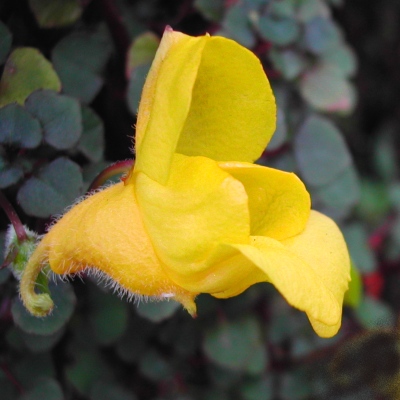| Home |
Strange Wonderful Things
Rare and exotic plants
|
 |
Impatiens repens

Germinating the seeds
Plant your seeds immediately for best germination
Getting started -- Use well-draining soil. A typical mix is 2 parts potting soil to 1 part perlite or coarse sand.
An alternate mix is 3 parts perlite to 2 parts coir fiber or peat moss.
Use small containers or cups that have drainage holes at the bottom. Fill the
pots with soil and place a seed or 2 on the surface. If you have
long-fiber sphagnum moss (not ground peat moss), sprinkle some on the
surface. This helps retain moisture around the seeds while allowing light
to reach them, which aids germination.
This photo shows how much moss to use.
If you don't have the moss, sprinkle some of your soil mix around the seeds. Add water until everything is evenly moist (but not soggy).
Until the seeds sprout, ensure that the surface soil always stays moist. A plastic dome or bag
is good for maintaining moisture, but leave it open a crack to allow some fresh air in. You may need to drip a few drops of water over the seeds every day to keep the seeds
moist.
The ideal temperature for germination is between 65 to 77 degrees F (18-25°C). A little cooler at night is ok.
Avoid letting them get above 80° F (27°C). I recommend placing a minimum/maximum thermometer near the pots.
A fluorescent or LED bulb kept 4 inches (10 cm) away provides the right amount of
light. Protect from direct sun.
They should start germinating in 3 to 5 weeks, but allow up to 8 weeks for any slow ones to sprout.
Increase air ventilation slightly after sprouting to prevent rot, but continue keeping the
soil surface moist for 3 weeks after sprouting.
Growing onward...
Lighting -- This Impatiens prefers filtered sunlight or very bright shade. Avoid prolonged direct sun, unless it's early-morning sun.
Fertilizing -- For the first month, it's best to give a very dilute (1/8
strength) liquid fertilizer.
Hydroponic fertilizer
is perfect for young seedlings, since it is easily absorbed and complete.
After the first month, you may switch to a granular fertilizer,
following the directions on the package. Or feed monthly with a liquid fertilizer at half strength.
It's normal for older leaves to occasionally turn yellow and then brown, but if it seems excessive, check that the soil is moist enough down in the root zone.
If it is, the plant may need more nitrogen fertilizer.
Transplanting -- When your plants are 2-3 months old, you may gently
transfer them to a larger pot. Water the soil first, and avoid letting the
soil ball break apart, which can damage the roots. After transplanting,
give no sun or liquid fertilizer the first week.
Watering -- Aim to keep the soil moist, but not soggy. Never let it dry
out completely. You may use a moisture meter probe to monitor the moisture levels down in the root zone.
Climate -- Impatiens repens needs temperatures above 50 degrees F
(10°C). It's possible that very hot conditions may hinder flowering or
stress the plant, especially if nights are warm. Some humidity is needed for it
to thrive ― over about 40% is best. If your room humidity gets too low, consider using an ultrasonic room humidifier, which you can
get at home improvement
stores and thrift shops.
Pests to watch for -- Look for pests that can affect your other
plants. Be careful when choosing chemical remedies, because some may harm the plant. Email me if you have questions.
Have fun growing them!
- Jeff
Strange Wonderful Things
| Home |
Strange Wonderful Things
Rare and exotic plants |

|
| Entire site Copyright 2003-2023 by Strange Wonderful Things, except as noted |
|


